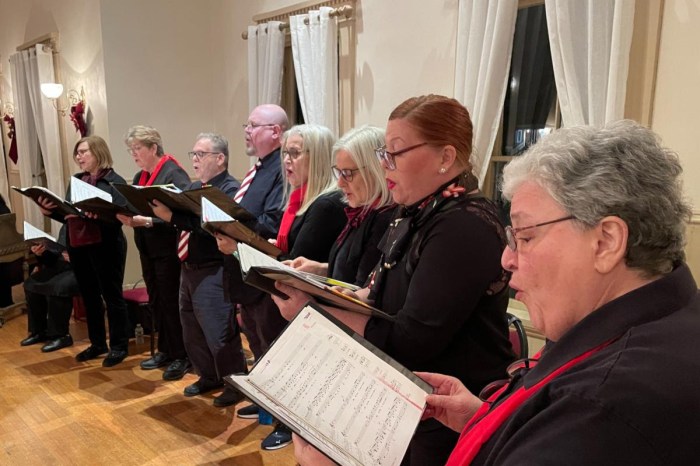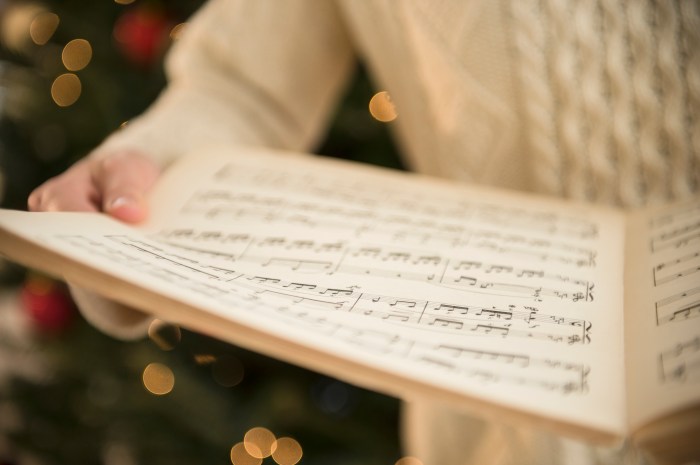500+ Galleries Open Their Doors For 3 Days
Seven is the lucky number for Bushwick Open Studios, the (mostly) free weekend-long art festival that, in its seventh year, has expanded to include sections of Bed-Stuy, Williamsburg and Ridgewood, Queens.

Organized by the all-volunteer community group Arts In Bushwick (AiB), Bushwick Open Studios (BOS) nailed what it’s done well in the past- namely opening up a vista of visual art throughout the neighborhood and beyond- while also growing to include more new modes of expression and engage the community at large in a way that the event didn’t in previous years.
Some of the new events focused purely on film or live music, others drew attention to niche mediums like crocheting, cooking and homemade video games, which boder on craft in an event known for visual art.
The festival, which kicked off on Friday, May 31, culminated in a Sunday afternoon Community Day held in Maria Hernandez Park that aimed to bridge the gap between the neighborhood’s burgeoning artist/transplant population and its longtime residents.

Murals bloom like gardens
Bushwick and neighboring East Williamsburg are known for their vibrant street murals, and BOS was an opportunity to showcase the newest additions.
Early Saturday morning, June 1, volunteers in a lot at 110 Moore St. were getting ready to unveil a mural that adorns the wall of a newly-opened community garden.
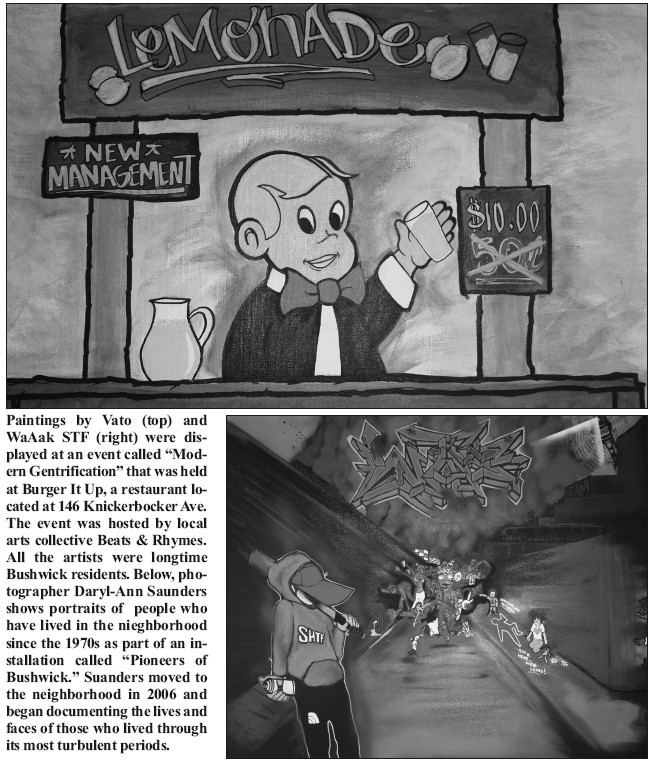
By 11 a.m., the grill was fired up, music was blaring, and everyone was congratulating one another on a job well done.
The mural is the fruit of a yearlong collaboration between Bushwick artist Miriam Castillo, students at the Beacon Center for Arts and Leadership, the Moore Street Market and the AiB community team, said Lauren Smith of AiB.
The organization asked students from J.H.S. 291 in Bushwick: “How does food unite people?” The mural incorporated their responses and was designed by Castillo. Kids and volunteers had been working to bring the design to life since mid-April, Smith said.
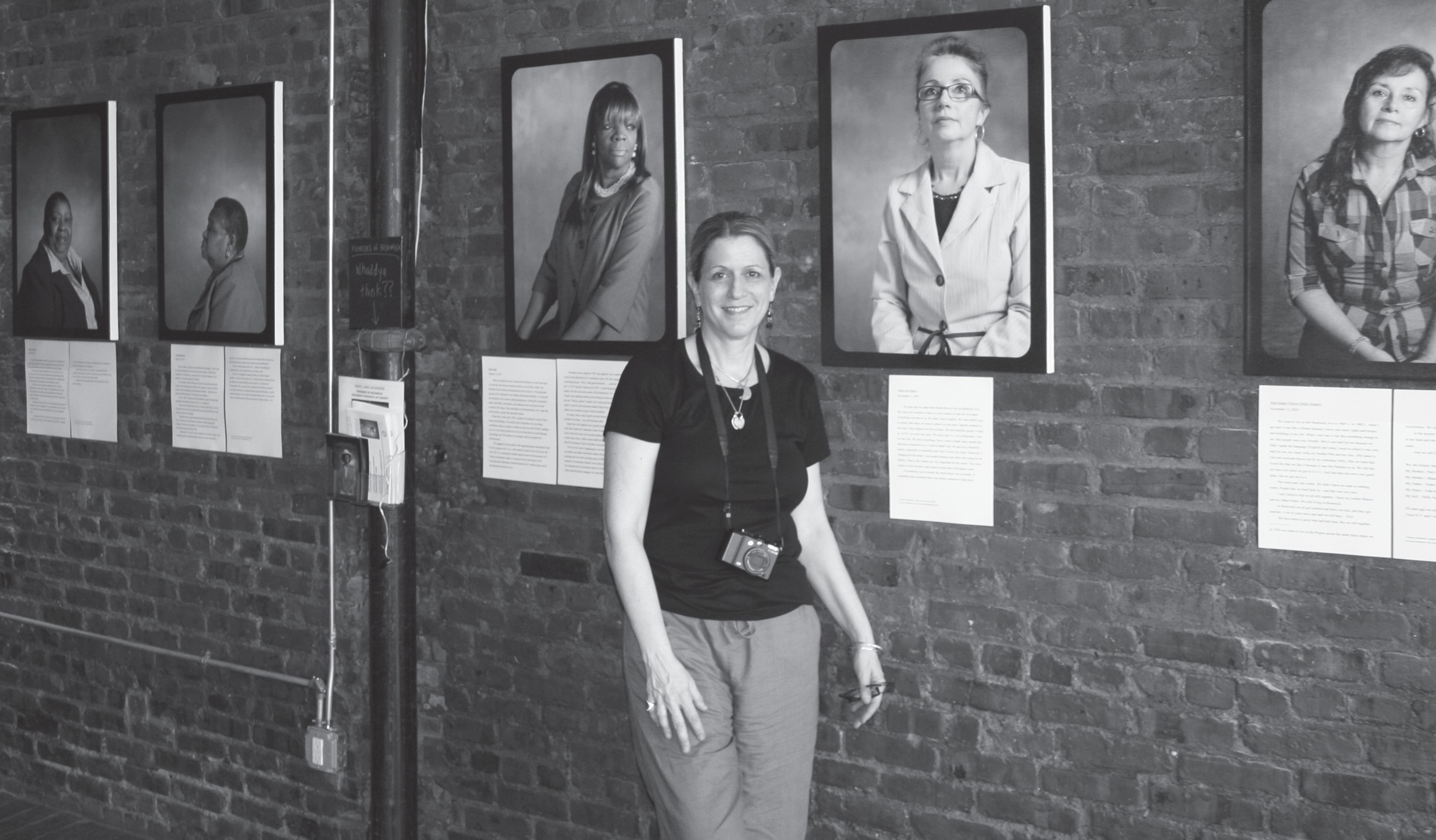
Emmanuel, a student at J.H.S. 291 who was part of the project since the beginning, said it wasn’t his first mural and it won’t be his last. He said he is an aspiring artist who creates Japanese style anime.
Dante, another student involved from the get-go, said he enjoyed the experience, though his artistic aspirations lie in hip-hop. He would perform at the BOS Community Day held at Maria Hernandez Park the next day, but said he was unsure what time the performance would take place.
Though the mural had unfurled its pedals for the first time, the garden it sits in, is still sprouting.

Johnathan Boe, co-founder of OKO Farms, runs the garden with business partner Yemi Ame. He said the two began building in March when they secured the location with help from the Brooklyn Economic Development Council.
The going is slow but steady, he said-the garden is being built with donations and the help of volunteers.
But, it’s not just a matter of throwing seeds in the ground-this is an “aquaponic garden,” Boe said. The gardeners are growing vegetables and something you don’t often see in inner-city gardens: Fish.
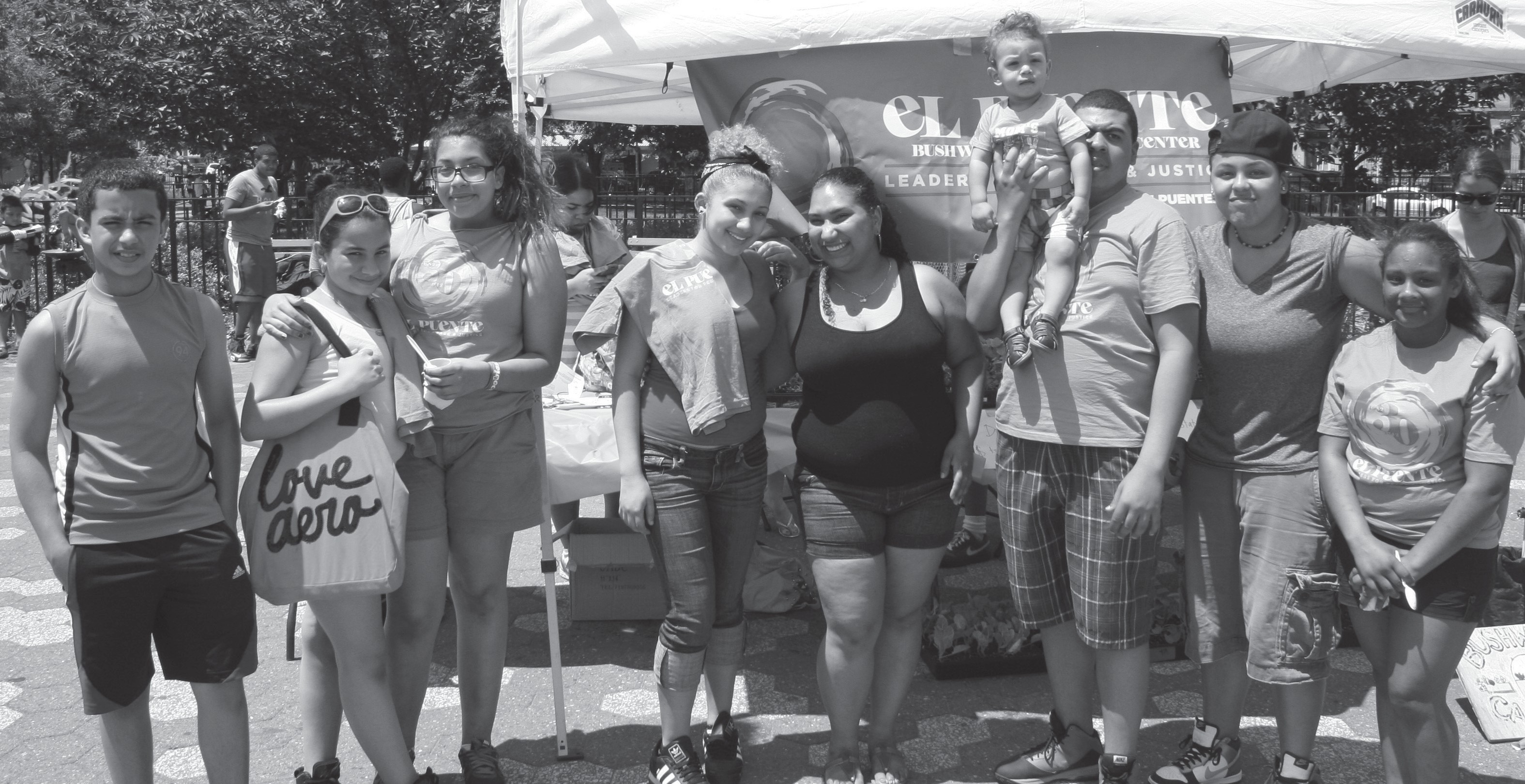
The farmers will grow fish in a pond in the garden and use the tank’s water, which is heavy with plant-fertilizing fish waste, to water organic crops, according to Ame.
Portions of the plants-as well as bugs that live in the garden, are used to feed the fish-Boe said, adding that the system is highly sustainable, though the fish require more food than the garden can provide.
Ame said the process is the purest form of organic farming, because the limited chemicals allowed in most organic farming operations cannot be used in aquaponics-they’d kill the fish.
Boe said the garden’s yield will be sold and used to finance the garden, which he and Ame are building as a form of charitable community service. Creating Aquaponic gardens is actually their day job, too, but both said they are not being paid to build the one at 110 Moore St.-in fact, they’re helping to finance it.
Gentrification with a side of fries
Burger It Up, a relatively new restaurant on the corner of Knickerbocker and Flushing Avenues in Bushwick, displayed paintings and mixed-media collages from three Bushwick natives.
The display was a collaboration- called “Dash to Dine: ‘Modern Gentrification'”- between art collective Arts & Rhymes and artists WaAak STF, Monel and Vato, according to Brian Camacho (aka Mr. Radio), who organized the event.
Camacho said the artists were personal friends that he chose for the event because it was “only right to have Bushwick residents.” Camacho was raised in Williamsburg and now resides in Bushwick as well.
The works explored the tension between Bushwick’s “native” community and the forces of gentrification-capitalism, renovation hungry landlords and the transplant population.
A painting by WaAak depicts a horde of ghoulish green figures clad in plaid shirts and ripped denim jackets marauding through the streets, trampling regular-looking folks. A small girl sits on the sidewalk next to the chalk outline of a body and writes “Your here.. now leave! [sic]”
Other pieces were a little more tongue-in-cheek.
Paintings by Vato repurpose pop culture icons to make a statement about the economic effects gentrification has on local residents-particularly renters.
One image shows Snoopy’s signature red dog house with a sign displaying the word “foreclosed” in a street tag font.
Another depicts cartoon character Richie Rich smiling behind a lemonade stand. The price of lemonade has been changed from 50 cents to $10.
A third painting shows the Warner Brothers mascot holding a sign that pleads: “Hire a brother.” (Some have accused the mascot of representing blackface and minstrelsy.)
How the west was won
Just across Flushing Avenue, at the mini-mall/artspace collective Shops At The Loom, Daryl-Ann Saunders is showcasing work that focuses on older Bushwick natives in a series called “Pioneers of Bushwick.”
The showcase combines portraits of people who have lived in the neighborhood since the 1970s with their personal anecdotes about living in the neighborhood.
These are the pioneers who rode out the rough times, she said, counterbalancing the fomenting criminal element in a neighborhood that was a destination for buyers and sellers of narcotics for more than a decade.
Saunders moved to Bushwick in 2006, and shortly after arriving, she witnessed a gruesome murder scene outside of her apartment.
The event inspired her to document the experiences of people who have been living through that kind of violence for many years.
She said she attended several community board meetings used bi-lingual fliers to reach out to community members in order to find her subjects.
In fact, her list of subjects includes Community Board 4 chair Julie Dent, board member Robert Camacho and longtime board member/community activist Avellar Hansley.
However, those connectons came after she made serious inroads with the community. She said her outreach efforts weren’t very fruitful until the Brooklyn Arts Council awarded her with an artists’ residency at the Diana Jones Center in Bushwick.
“It gave me credibility,” she said. “It’s not like I was saying ‘Hey do you want to come to my house and see my etchings,'” she joked.
Persistence played a huge role, too, she said.
Saunders met with each subject at least twice-one session was for photos; in subsequent sessions, subjects wrote their statements and gave Saunders more historical context, she said.
The portraits are accompanied by blurbs and anecdotes about the neighborhood that were written by her subjects.
Saunders said she had the individuals write their remembrances by hand, because it was more authentic and gave a sense of who they were. But for the gallery, Saunders typed the messages so they would be more legible for readers.
“There’s a lot of newcomers, and I look at it as a way for people to understand each other better,” she said of the series. “A lot of times when people come into a neighborhood, they think they’re the first ones that made it cool or made it good-it sort of washes away a lot of the past history. … I wanted to have, sort of, a little bookmark for the people that persevered and were here through all of the really tough times.”
The project debuted in 2011, and Saunders has continued collecting portraits and anecdotes since then.
“I got kind of hooked,” she said.
Wood and words
A few blocks further, tucked away in East Williamsburg’s industrialzone turned-art-hub, is Kurt Steger’s studio at 66 Knickerbocker Ave.
Steger, a former furniture-maker runs a frame shop with his wife and fellow artist, Meg Hitchcock, in The Bogart Building at 56 Bogart St.-also in East Williamsburg. Steger creates sculptures from found and repurposed pieces of wood and other scrap materials.
“I haven’t had to buy a scrap of wood since I moved here,” he said.
Steger came to Brooklyn about nine months ago from a 200-acre farm in Virginia, he said. Rural influences are evident in his work, which twists fallen limbs and twigs into ethereal 3- D shapes bound by canvas and twine.
Signature pieces from his Virginia days feature a short log-one to two feet, maybe-whose ends are connected by a curving arch of ribbed, painted wood, making a ring that stands a few feet tall.
While it’s all the same material, the relatively untouched log and the treated, manipulated connecting ring create a juxtaposition that evokes humanity’s connection with-attempts to shape-nature, he said.
Steger cautioned that the reading is simply his take on the work, and he’d rather let the viewer do his or her own interpreting.
Since moving to Brooklyn, Steger has had no dearth of supplies, and his medium is beginning to shift slightly, though gathering materials is always an act of finding, he said.
“I’m finding myself starting to use chunks of concrete that I’m finding around here, so it’s like the debris of Bushwick,” he said.
The cityscape has begun to creep into his creative consciousness too, it appears. Next to curved, earth-toned Virginia-era works are rigid wooden frameworks that look like scaffolding. Small canvas sacks suspended by rope tied to a wooden arm are evokative of construction cranes.
One eye-catching piece features a tree branch that is framed by scaffolding made from treated lumber. Steger found the branch near Maria Hernandez Park. Over night, someone hacked apart a tree, and Steger took the small, mangled branch whose two halves were barely hanging together, he saaid.
As he was gathering materials for the scaffolding, he noticed some of the lumber had a stamp from Weyerhaeuser Select-arguably the largest timber company in the world, he said.
“So [the piece] is this contrast between Wayerhauser, that’s cutting down millions of trees as opposed to this one guy who cut down one tree,” he said. “It’s like this double act of violence that I’m bringing together.”
Hurricane Sandy was a boon for Steger, who used pieces of a downed tree to make a sculpture titled “Sandy.
Kurt’s wife, Meg Hitchcock, also showed her work in Steger’s space. Hitchcock cuts up one sacred text and turns it into another. Portions of the Quaran become the Lord’s Prayer; a section of the Bible is transformed into a Zen sutra on the nature of emptiness; letters from Salman Rushdie’s Satanic Verses become the ubiquitous Muslim expression “Allahu Akbar.”
Hitchcock said she aims to transcend any one religion with her pieces, which she calls drawings.
One such drawing uses letters from the Quaran to spell out the Lord’s Prayer, which is encircled by the phrase “Subhan’Allah”-a Muslim expression translated to “Glorious is God”-made with letters cut from Ecclesiastes.
“So it goes beyond Christianity; it goes beyond Islam; and it becomes something else-whatever that ‘something else’ is,” she said. “It could be humanity.”
Hitchcock said she lived as a bornagain Christian until the age of 30 before “leaving that life.”
“It’s the most liberating thing ever,” she said. “If you’re really in the confines of [a religion], psychologically, and then you break free, life begins.”
She said her work is meant to liberate sacred texts from dogma to draw attention to the wors’ inherent poetry.
“I love sacred texts,” she said. I think they’re really amazingly beautiful as long as they’re free of the dogma. They’re like prison sentences, in a way, if you’re completely attached to them.”
She said her work is not meant to defame, but rather to draw attention to the beauty of the written word. Hitchcock hasn’t caught much flak from the pious, she said, adding she chalks that up to living in the notoriously liberal New York City. She joked that she has no shows planned for the Deep South or the Middle East.
Pieces that play between Christianity and Islam are meant to remind viewers of the religions’ shared roots.
“It says ‘Our Father who art in heaven-well, which father?” she said. “Is it the christian God or the Islamic God? Well, they’re the same, because they’re Abrahamic religions.”
She said she has received friendly warnings from Islamic groups who told her that she should be careful about where she displays her work. A group of Muslim women dropped by the studio during BOS to see her work, which she said they enjoyed. Hitchcock said they women even helped her learn the correct pronunciation for some of the Arabic phrases in her pieces.
She added that she only uses English translations of the Quaran and would never cut an Arabic version, which is considered not only the word of God, but also his embodiment.
She will be holding a solo show in Studio 10 of the Bogart Building in October.
Open studios, open spaces
Further west lies 3rd Ward, a cooperative work space/studio that offers classes on everything from bicycle repair to HTML 5, and which hosted BOS’s “Seeking Space”-a gallery for artists who needed a gallery.
The defacto gallery, located at 195 Morgan Ave, is hosting more than 30 artists who work in a variety of media until June 16. There are video installations, sculptures, paintings and mixedmedia collages that incorporate found objects.
A piece by brooklyn-based artist Miranda Nichols brings together sketches, paint and various clippings that leap off the page.
Guiselt Thaiz incorporates far-eastern illustration styles with the contemporary image of a swimming pool.
An impressionistic interior by Raisa Nosova titled “Rochester, NY” hits a sentimental note as two teenage girls confide in one another in a cluttered attic. One girl looks you dead in the eye as if to say: “What are you doing here?”
While many pieces used relatively traditional mediums, others broke new ground. A Sculpture by Miami-based London Tsai used figures created with a 3-D printer-an emerging technology that is finding its way into art.
Party in the park
BOS organizers tried to reach out to the community in a new way this year, holding an all-day, all-ages event in Maria Hernandez Park.
Along with games and musical performances, several groups tabled at the event to avail residents of their various community services.
El Puente, a community education and human rights institution, made its presence known.
The Williamsburg-based nonprofit has five locations in North Brooklyn that offer academic enrichment, arts programming, health and wellness education and leadership training for kids and adults, according to Shy Richardson, who tabled for the organization at the community day.
The Bushwick Food Cooperative, a member-run grocery store located at 2 Porter Ave., also passed out information in the park.
The co-op offers members organic, locally sourced food from Brooklyn, upstate New York and Pennsylvania, according to co-op member Lucy Chen.
Anyone can shop at the co-op, but members pay the lowest prices, she said. According to the co-op’s website, the shop buys wholesale, and members pay 24 percent above wholesale price. Non-members pay a 60 percent markup, which is about the same markup one would pay at a grocery store or bodega, it noted.
Chen said membership is easy. To become a member, one has to pay a one-time fee of $50, which can be paid in installments, and work for the co-op for four hours a month.
Work can include typical tasks like manning a cash register and stocking shelves, or it can entail community outreach, market research and other non-traditional tasks, Chen said.
She noted the one-time fee is discounted for individuals on food stamps-they pay only $15 and can also make the payment in installments, she said.
Jag Davies, who handles marketing for the co-op said members can get food that far surpasses the quality of grocery stores in Bushwick for a price that’s a less than what they would pay at Wholefoods.
Still, he said it’s been a tough sell to longtime residents, because the prices are higher than they are used to paying, and there are upfront costs involved in membership.
It’s all a matter of explaining the value, he said.
Sunday at the Cinema
In another first for BOS, the festival held a film screening as part of its closing ceremonies. The screening was split into two halves: “Concrete” and “flux.”
Concrete featured short films inspired by city life; flux showcased experimental works.
Standout films among those at the screening included “Las Mañanitas” by Gabriella Moses and “ADAM” by Augustin Doublet.
“Las Mañanitas” followed Ana Isabel, a girl living in the Lower East side who is tempted to lose her virginity days before her quinceañera.
The virgin Mary appears to the girl, first in a burnt plantain at the diner she works in, and later as a vision.
She’s torn between morals and desire as she tries to get everyone around her to believe she even had the vision.
After convincing family, friends, and reporters that the Holy Mother will appear at her coming-of-age, she sets out to fake the miracle, but something magical happens.
“ADAM” is a story of star-crossed lovers. While trying to earn money by betting on shell games under the J Train, Adam, a black teen who lives in a Bushwick housing development meets Coco, an overprivileged movie actress who wanders the neighborhood for kicks.
He catches her after she pick-pockets him, and after a rocky start, he becomes an escort and confidante.
The film’s premise was a little too fairy tale-esque, but its imagery and the depiction of Adam’s everyday life in Bushwick was engaging.
Check out next week’s Times Newsweekly for the second half of our BOS coverage. It will feature photos, stories and poetry from people who have spent their lives in the neighborhood, as well as the run-down on a walking tour hosted by John Dereszewski, Bushwick’s former district manager, and Adam Schwartz, a historian who has taught in the neighborhood for more than a decade.



